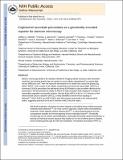Engineered ascorbate peroxidase as a genetically encoded reporter for electron microscopy
Author(s)
Deerinck, Thomas J.; Sancak, Yasemin; Poulos, Thomas L.; Mootha, Vamsi K.; Sosinsky, Gina E.; Ellisman, Mark H.; Martell, Jeffrey Daniel; Ting, Alice Y.; ... Show more Show less
DownloadTing_Engineered ascorbate.pdf (3.524Mb)
PUBLISHER_POLICY
Publisher Policy
Article is made available in accordance with the publisher's policy and may be subject to US copyright law. Please refer to the publisher's site for terms of use.
Terms of use
Metadata
Show full item recordAbstract
Electron microscopy (EM) is the standard method for imaging cellular structures with nanometer resolution, but existing genetic tags are inactive in most cellular compartments[superscript 1] or require light and can be difficult to use[superscript 2]. Here we report the development of 'APEX', a genetically encodable EM tag that is active in all cellular compartments and does not require light. APEX is a monomeric 28-kDa peroxidase that withstands strong EM fixation to give excellent ultrastructural preservation. We demonstrate the utility of APEX for high-resolution EM imaging of a variety of mammalian organelles and specific proteins using a simple and robust labeling procedure. We also fused APEX to the N or C terminus of the mitochondrial calcium uniporter (MCU), a recently identified channel whose topology is disputed[superscript 3, 4]. These fusions give EM contrast exclusively in the mitochondrial matrix, suggesting that both the N and C termini of MCU face the matrix. Because APEX staining is not dependent on light activation, APEX should make EM imaging of any cellular protein straightforward, regardless of the size or thickness of the specimen.
Date issued
2012-10Department
Massachusetts Institute of Technology. Department of ChemistryJournal
Nature Biotechnology
Publisher
Nature Publishing Group
Citation
Martell, Jeffrey D, Thomas J Deerinck, Yasemin Sancak, Thomas L Poulos, Vamsi K Mootha, Gina E Sosinsky, Mark H Ellisman, and Alice Y Ting. “Engineered Ascorbate Peroxidase as a Genetically Encoded Reporter for Electron Microscopy.” Nature Biotechnology 30, no. 11 (October 21, 2012): 1143–1148.
Version: Author's final manuscript
ISSN
1087-0156
1546-1696